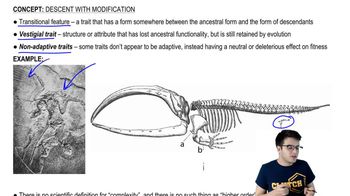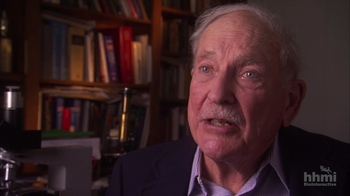Table of contents
- 1. Introduction to Biology2h 42m
- 2. Chemistry3h 40m
- 3. Water1h 26m
- 4. Biomolecules2h 23m
- 5. Cell Components2h 26m
- 6. The Membrane2h 31m
- 7. Energy and Metabolism2h 0m
- 8. Respiration2h 40m
- 9. Photosynthesis2h 49m
- 10. Cell Signaling59m
- 11. Cell Division2h 47m
- 12. Meiosis2h 0m
- 13. Mendelian Genetics4h 44m
- Introduction to Mendel's Experiments7m
- Genotype vs. Phenotype17m
- Punnett Squares13m
- Mendel's Experiments26m
- Mendel's Laws18m
- Monohybrid Crosses19m
- Test Crosses14m
- Dihybrid Crosses20m
- Punnett Square Probability26m
- Incomplete Dominance vs. Codominance20m
- Epistasis7m
- Non-Mendelian Genetics12m
- Pedigrees6m
- Autosomal Inheritance21m
- Sex-Linked Inheritance43m
- X-Inactivation9m
- 14. DNA Synthesis2h 27m
- 15. Gene Expression3h 20m
- 16. Regulation of Expression3h 31m
- Introduction to Regulation of Gene Expression13m
- Prokaryotic Gene Regulation via Operons27m
- The Lac Operon21m
- Glucose's Impact on Lac Operon25m
- The Trp Operon20m
- Review of the Lac Operon & Trp Operon11m
- Introduction to Eukaryotic Gene Regulation9m
- Eukaryotic Chromatin Modifications16m
- Eukaryotic Transcriptional Control22m
- Eukaryotic Post-Transcriptional Regulation28m
- Eukaryotic Post-Translational Regulation13m
- 17. Viruses37m
- 18. Biotechnology2h 58m
- 19. Genomics17m
- 20. Development1h 5m
- 21. Evolution3h 1m
- 22. Evolution of Populations3h 52m
- 23. Speciation1h 37m
- 24. History of Life on Earth2h 6m
- 25. Phylogeny2h 31m
- 26. Prokaryotes4h 59m
- 27. Protists1h 12m
- 28. Plants1h 22m
- 29. Fungi36m
- 30. Overview of Animals34m
- 31. Invertebrates1h 2m
- 32. Vertebrates50m
- 33. Plant Anatomy1h 3m
- 34. Vascular Plant Transport1h 2m
- 35. Soil37m
- 36. Plant Reproduction47m
- 37. Plant Sensation and Response1h 9m
- 38. Animal Form and Function1h 19m
- 39. Digestive System1h 10m
- 40. Circulatory System1h 57m
- 41. Immune System1h 12m
- 42. Osmoregulation and Excretion50m
- 43. Endocrine System1h 4m
- 44. Animal Reproduction1h 2m
- 45. Nervous System1h 55m
- 46. Sensory Systems46m
- 47. Muscle Systems23m
- 48. Ecology3h 11m
- Introduction to Ecology20m
- Biogeography14m
- Earth's Climate Patterns50m
- Introduction to Terrestrial Biomes10m
- Terrestrial Biomes: Near Equator13m
- Terrestrial Biomes: Temperate Regions10m
- Terrestrial Biomes: Northern Regions15m
- Introduction to Aquatic Biomes27m
- Freshwater Aquatic Biomes14m
- Marine Aquatic Biomes13m
- 49. Animal Behavior28m
- 50. Population Ecology3h 41m
- Introduction to Population Ecology28m
- Population Sampling Methods23m
- Life History12m
- Population Demography17m
- Factors Limiting Population Growth14m
- Introduction to Population Growth Models22m
- Linear Population Growth6m
- Exponential Population Growth29m
- Logistic Population Growth32m
- r/K Selection10m
- The Human Population22m
- 51. Community Ecology2h 46m
- Introduction to Community Ecology2m
- Introduction to Community Interactions9m
- Community Interactions: Competition (-/-)38m
- Community Interactions: Exploitation (+/-)23m
- Community Interactions: Mutualism (+/+) & Commensalism (+/0)9m
- Community Structure35m
- Community Dynamics26m
- Geographic Impact on Communities21m
- 52. Ecosystems2h 36m
- 53. Conservation Biology24m
21. Evolution
Introduction to Evolution and Natural Selection
Problem 8`
Textbook Question
Within a few weeks of treatment with the drug 3TC, a patient's HIV population consists entirely of 3TC-resistant viruses. How can this result best be explained? a. HIV can change its surface proteins and resist vaccines. b. The patient must have become reinfected with a resistant virus. c. A few drug-resistant viruses were present at the start of treatment, and natural selection increased their frequency. d. HIV began making drug-resistant versions of its enzymes in response to the drug.
 Verified step by step guidance
Verified step by step guidance1
Step 1: Understand the concept of natural selection. Natural selection is a process where individuals with traits that provide a survival or reproductive advantage are more likely to pass on those traits to the next generation. In the context of HIV, this means that viruses with mutations that confer drug resistance are more likely to survive and replicate in the presence of the drug.
Step 2: Recognize that mutations in HIV occur naturally during replication. HIV has a high mutation rate due to the error-prone nature of its reverse transcriptase enzyme. This means that even before treatment begins, there may already be a small population of viruses with mutations that make them resistant to 3TC.
Step 3: Analyze the effect of the drug 3TC on the HIV population. When treatment with 3TC begins, the drug inhibits the replication of non-resistant viruses. However, viruses with the resistance mutation are not affected by the drug and continue to replicate.
Step 4: Consider the role of selective pressure. The presence of 3TC creates a selective pressure that favors the survival and replication of resistant viruses. Over time, the resistant viruses become the dominant population because they are the only ones able to replicate effectively in the drug's presence.
Step 5: Evaluate the options provided in the question. Based on the principles of natural selection and mutation, the best explanation is that a few drug-resistant viruses were present at the start of treatment, and natural selection increased their frequency (option c).
 Verified video answer for a similar problem:
Verified video answer for a similar problem:This video solution was recommended by our tutors as helpful for the problem above
Video duration:
47sPlay a video:
Was this helpful?
Key Concepts
Here are the essential concepts you must grasp in order to answer the question correctly.
Natural Selection
Natural selection is a process where organisms better adapted to their environment tend to survive and produce more offspring. In the context of HIV treatment, if a few drug-resistant viruses are present before treatment, they can survive the selective pressure of the drug, leading to an increase in their frequency in the viral population.
Recommended video:

Natural Selection
Viral Mutation and Resistance
Viruses, including HIV, can mutate rapidly, leading to variations in their genetic makeup. Some of these mutations may confer resistance to antiviral drugs, allowing those resistant strains to thrive when the drug is administered, as seen with 3TC treatment.
Recommended video:
Guided course

Mutations
Reinfection with Resistant Strains
Reinfection occurs when a patient contracts a new strain of a virus after being infected with a different strain. In the case of HIV, if a patient becomes reinfected with a strain that is already resistant to 3TC, this could explain the rapid emergence of a resistant viral population.
Recommended video:
Guided course

Adaptive Immune Response

 4:58m
4:58mWatch next
Master Evolution and Natural Selection with a bite sized video explanation from Jason
Start learningRelated Videos
Related Practice
































